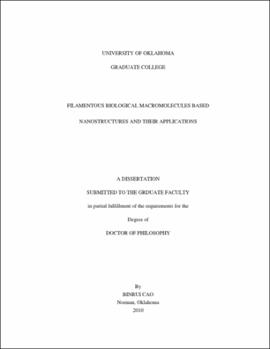Filamentous Biological Macromolecules Based Nanostructures and Their Applications
| dc.contributor.advisor | Mao, Chuanbin | |
| dc.creator | Cao, Binrui | |
| dc.date.accessioned | 2019-04-27T21:38:47Z | |
| dc.date.available | 2019-04-27T21:38:47Z | |
| dc.date.issued | 2010 | |
| dc.identifier | 9949963702042 | |
| dc.identifier.uri | https://hdl.handle.net/11244/319247 | |
| dc.description.abstract | In nanoscience, one promising strategy for achieving precise placements of nanomaterials and specific recognitions between individual build blocks is to use self-ordered templates to arrange them into designed pattern. Refined bio-molecules from nature, such as nucleic acids, proteins and viruses, have beautiful hierarchical nanostructures and precise molecular recognition capabilities, which make them ideal templates for fabricating hierarchical nanostructures. One branch of such biological templates is filamentous biological macromolecules like spider silks, M13 phages, tobacco mosaic virus, etc. The beauty of filamentous biological templates is that they can assemble functional nanomaterials into one-dimensional, two-dimensional or three-dimensional organizations with controlled size, shape, alignment and orientation. | |
| dc.description.abstract | This thesis presents the synthesis and assembly of nanomaterials on individual or self-assembled filamentous biological templates including spider dragline silks, bacteriophages and bacterial pili. Specifically, we found: (1) Spider dragline silks could induce the nucleation of hydroxyapatite (HAP) crystals with preferred orientation; (2) The interactions between microtubule-associated proteins (MAPs) and microtubules were studied by biopanning of a phage displayed random peptide library against purified tubulins; (3) HAP-binding phages had an ability to attract and assemble HAP nanorods into a HAP-phage hybrid for bone regeneration; (4) Films made from bacteriophages could serve as a scaffold for the controlled growth and differentiation of resident mesenchymal stem (MSC) cells; (5) Rodlike bacterial pili particles could be induced to self-assemble into a novel colloidal crystal for nanosynthesis. | |
| dc.format.extent | 269 pages | |
| dc.format.medium | application.pdf | |
| dc.language | en_US | |
| dc.relation.requires | Adobe Acrobat Reader | |
| dc.subject | Macromolecules | |
| dc.subject | Nanostructured materials | |
| dc.title | Filamentous Biological Macromolecules Based Nanostructures and Their Applications | |
| dc.type | text | |
| dc.type | document | |
| dc.thesis.degree | Ph.D. | |
| ou.group | College of Arts and Sciences::Department of Chemistry and Biochemistry |
Files in this item
This item appears in the following Collection(s)
-
OU - Dissertations [9338]
